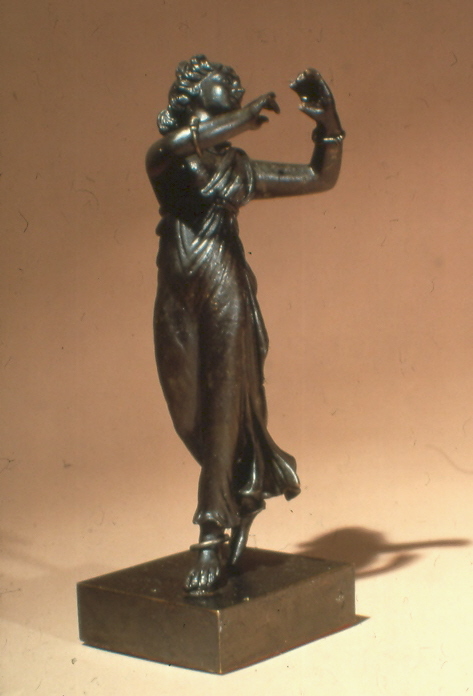
Unknown
Roman
Auletris, 1st c. CE, to 2nd c. CE
bronze and silver
6 3/8 x 2 7/8 x 2 3/8 in.
SBMA. Gift of Wright S. Ludington
1981.64.4
POSTSCRIPT
This object was previously titled Dancing Girl with bronze and silver jewelry, and classified as a Greek Bronze from Asia Minor ca. 200 BCE.
COMMENTS
This little bronze dancing girl with silver necklace arm bands and ankle bracelet was a gift to the Museum by Wright Ludington. Dated about 200 BCE, she came from Asia Minor and is a reflection of Hellenistic-Greek influence on that region. That influence was due to the cultural as well as military conquests of Alexander the Great of Macedonia.
Art for the joy of it, almost a religion of beauty and refinement, is a Greek contribution to the world. Here in this spirited little bronze, the pleasure the sculptor took can be seen in his rendering of the young girl's agile body as she twists and turns in response to music. She is balanced and in control yet there is freedom and rapture in her upward glance and in the swinging gesture of her arms. Her hair flies up and her skirt flutters out below. She wears the traditional Greek chiton which is caught at the left shoulder and covers one breast leaving the right arm free. The skirt flies out behind her heel as she dances. She is moving gracefully in open space. This extension of the spatial environment is often associated with the Hellenistic Kingdoms of Pergamum and Rhodes in Asia Minor. Here the spiral movement of the figure makes the viewer aware of the third dimension. The sculptor achieved shadows and gradations of shadows by subtle variation of surface carving while light catches the higher.surfaces. The technique is almost painterly. The fluid movement of her body is seen under the soft material which covers her breast, stomach, thigh, and legs. This is a fine example of Hellenistic art and reflects the international world culture which produced it.
Prepared for The Docent Council by Mary Kent Scott
SBMA CURATORIAL LABELS
An "auletris" was a female slave entertainer in an ancient Greek symposium, essentially an aristocratic drinking party for men that originated in the seventh century B.C.E. Our figurine is dancing while playing what we must imagine to be a double flute (now missing), inviting us—the likely inebriated participants of this exclusive party—to hear the melody, and move our body in concert with hers. As we interact with her in this way, this static object comes to life, transporting us to a mythical past.
- Sculptures that Tell Stories, 2019
